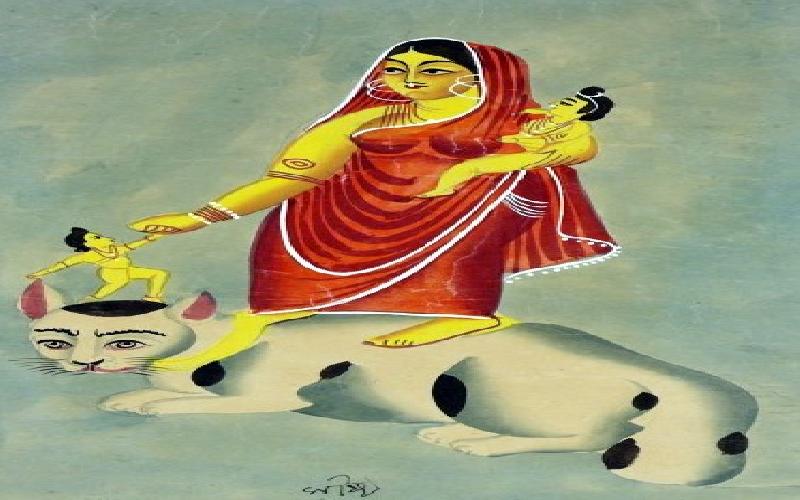Shashti or mother Shashti is a Hindu folk Goddess who is related to protection and benefaction of children. She is also the deity of reproduction or vegetation and is believed to bestow children to the parents. She is symbolized as a motherly figure riding on a cat and nursing one or more children. Cat is considered to be the vahana of Shashti.
According to legends there is an interesting story relating to Mother Shashti. According to Chapter in Shashtideviupakhyanam, King Priyavrata, the son of Syayambhuta Manu and his wife Malini performed a form of yajna called putrakameshti yajna. It was a
fire sacrifice to gain a male child.
After 12 years of the yajna a still-born child was given birth by Malini. So when Malini and Priyavrata went to cremate the child in the cremation ground, a celestial woman appeared before them. She was wearing jewels and silk dresses. She rode a heavenly chariot. She said she was Devasena, the daughter of Brahma and the wife of Skandha. Then she said she was known all over the world by the name of Shashti, the protector of children. She had the power of helping parents to beget children. She took the dead child with her and wanted to leave for heaven. Priyavrata stopped her.
She said she could give life to the child, subjected to Priyavrata and his wife worshipped Goddess shashti in the three worlds, Swarg, Marta and Patal, on the 6th day of every month. The same Mother Shashti was supposed to be
worshipped on the 6th day and 21st day of birth of the child. Priyavrata agreed to it. She gave life to the child and named her Subrata who became a famous ruler later. From that time all over the world Ma Shashti or Mother Shashti was worshipped with a Shalagrama and a purna ghata.
In Bengal there is also a tradition of celebrating aranya shashti (jamai shasti), on the 6th day of month of Jyestha. Women tie stone to small rag to the branch of tree, or tie thread in the hand of child. There are other shasti like Neel Shashti on the 6th day of Chaitra. It is worshipped on the auspicious day of marriage of Shiva with Parvati. As Shiva is also called Neelkantha, that means his throat is blue, after taking fast, women pour milk on the shivalingam. Ashoka Sashti is observed on the sixth day during the waxing phase of moon or Shukla Paksha. The flower buds of the Ashoka tree are consumed on the day by people. Ashoka tree is seen as a symbol of love and is also associated with the Kamdev, the Hindu God of love. Chapra Shashti is the other form of Shashti in Bengal. The noble culture and tradition relating to worship of mother Shashti should be taken up seriously in every part of the world.










